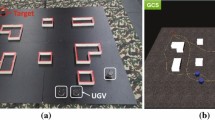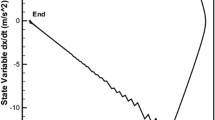Abstract
This paper proposes a novel model predictive control method with velocity estimation simultaneously constraining trajectory and velocity tracking errors for a cushion robot. The authors investigated a path planning method using improved particle swarm optimization (PSO) combined with Dijkstra’s algorithm and obtained a real-time desired optimal motion path for obstacle avoidance. The authors designed a velocity observer to estimate the unmeasurable speed, while the asymptotic stability of the observer error system was established. A predictive controller with error-constrained performance was derived by solving a quadratic programming problem with incremental control. Simulation and experimental results confirm the effectiveness of the proposed method and verify that the error constraints adopted in the cushion robot provide safe motion while avoiding obstacles.
Similar content being viewed by others
References
Liu Q, Liu D, and Meng W, Fuzzy sliding mode control of a multi-DOF parallel robot in rehabilitation environment, International Journal of Humanoid Robotics, 2014, 11(1): 1–29.
Mohammed S, Amirat Y, and Rifa H, Lower-limb movement assistance through wearable robots: state of the art and challenges, Advanced Robotics, 2012, 26(1): 1–22.
Sun P and Wang S Y, Redundant input safety tracking for omnidirectional rehabilitative training walker with control constraints, Asian Journal of Control, 2017, 19(1): 116–130.
Tan R P, Wang S Y, and Jiang Y L, Motion control of a cushion robot considering load change and center of gravity shift, Journal of System Design and Dynamics, 2012, 6(5): 740–753.
He W, Sam G S, Li Y N, et al., Neural network control of a rehabilitation robot by state and output feedback, Journal of Intelligent and Robotic Systems, 2015, 80(1): 15–31.
Sun P and Wang S Y, Redundant input guaranteed cost non-fragile tracking control for omnidirectional rehabilitative training walker, International Journal of Control, Automation, and Systems, 2015, 13(2): 454–462.
Zhao J, Jiang S, Xie F, et al., Adaptive dynamic sliding mode control for space manipulator with external disturbance, Journal of Control and Decision, 2018, DOI: https://doi.org/10.1080/23307706.2018.1487807.
Zhang T Y and Liu G P, Tracking control of wheeled mobile robots with communication delay and data loss, Journal of Systems Science and Complexity, 2018, 31(4): 927–945.
Niu B and Zhao J, Output tracking control for a class of switched non-linear systems with partial state constraints, IET Control Theory and Applications, 2013, 7(4): 623–631.
Yue M, Wu G Q, Wang S, et al., Disturbance observer-based trajectory tracking control for nonholonomic wheeled mobile robot subject to saturated velocity constraint, Applied Artificial Intelligence, 2014, 28(8): 751–765.
Valenzuela M J and Santibanez V, Robust saturated PI joint velocity control for robot manipulators, Asian Journal of Control, 2013, 15(1): 64–79.
Karl W, Mohamed W M, and Mario Z, Model predictive control of nonholonomic mobile robots without stabilizing constraints and costs, IEEE Transactions on Control Systems Technology, 2016, 24(4): 1394–1406.
Xiao H Z, Li Z J, and Yang C G, Robust stabilization of a wheeled mobile robot using model predictive control based on neurodynamics optimization, IEEE Transactions on Industrial Electronics, 2017, 64(1): 505–516.
Morgan D M and Chung S J, Model predictive control of swarms of spacecraft using sequential convex programming, Journal of Guidance, Control, and Dynamics, 2014, 37(6): 1725–1740.
Aditi C, Kanungobarada M, and Kommukuri V S, Model predictive current controller for performance enhancement of grid-integrated single-phase photovoltaic distributed generation plants, Transactions of Institute of Measurement and Control, 2016, 9(1): 1–14.
Chang H B, Sun P, and Wang S Y, Output tracking control for an omnidirectional rehabilitative training walker with incomplete measurements and random parameters, International Journal of System Science, 2017, 90(7): 1446–1456.
Mohamed A Z, Lee S H, and Has H Y, A faster planner using accelerated particle swarm optimization, Artificial life and Robotics, 2012, 17: 233–240.
Song B Y, Wang Z D, and Zou L, On global smooth path planning for mobile robots using a novel multimodal delayed PSO algorithm, Cognitive Computation, 2017, 9(1): 5–17.
Kim J J and Lee J J, Trajectory optimization with particle swarm optimization for manipulator motion planning, IEEE Transactions on Industrial Informatics, 2015, 11(3): 620–631.
Fu Y G, Ding M Y, and Zhou C P, Route planning for unmanned aerial vehicle on the sea using hybrid differential evolution and quantum-behaved particle swarm optimization, IEEE Transactions on System, Man, and Cybernetics: Systems, 2013, 43(6): 1451–1465.
Lee K B and Kim J H, Multiobjective particle swarm optimization with preference-based sort and its application to path following footstep optimization for humanoid robots, IEEE Transactions on Evolutionary Computation, 2013, 17(6): 755–766.
Sun P and Yu Z, Tracking control for a cushion robot based on fuzzy path planning with safe angular velocity, IEEE/CAA Journal of Automatica Sinica, 2017, 4(4): 610–619.
Tan R P, Wang S Y, and Jiang Y L, Motion control of a cushion robot considering load change and center of gravity shift, Journal of System Design and Dynamics, 2012, 6(5): 740–753.
Author information
Authors and Affiliations
Corresponding author
Additional information
This paper was supported by the National Key Research and Development Program under Grant No. 2016YF D0700104, Liaoning Province Natural Science Foundation under Grant No. 2019ZD0203; and Basic Research Program of Education Department Foundation of Liaoning Province under Grant No. LJGD2019017.
This paper was recommended for publication by Editor CHEN Benmei.
Rights and permissions
About this article
Cite this article
Sun, P., Shan, R. Predictive Control with Velocity Observer for Cushion Robot Based on PSO for Path Planning. J Syst Sci Complex 33, 988–1011 (2020). https://doi.org/10.1007/s11424-020-8375-x
Received:
Revised:
Published:
Issue Date:
DOI: https://doi.org/10.1007/s11424-020-8375-x




